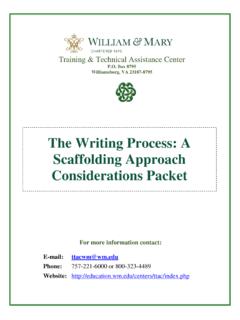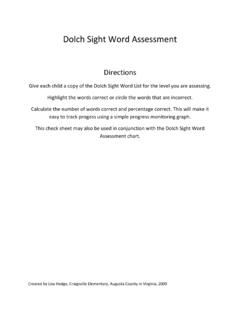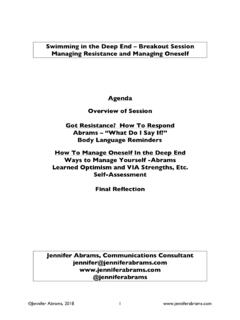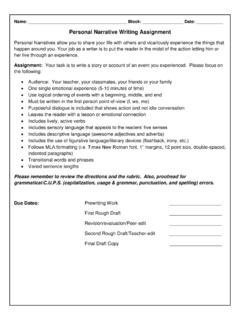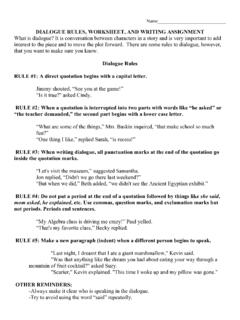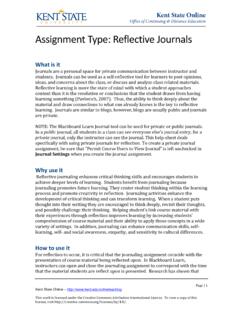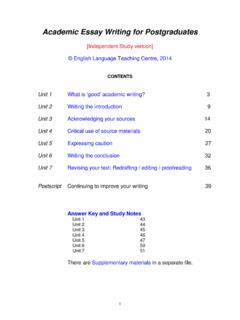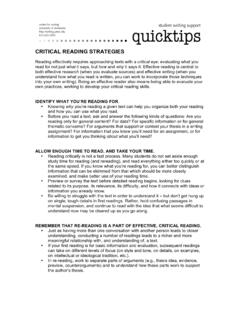Transcription of The Writing Process: A Scaffolding Approach Considerations ...
1 Training & Technical Assistance Center Box 8795. Williamsburg, VA 23187-8795. The Writing Process: A. Scaffolding Approach Considerations Packet For more information contact: E-mail: Phone: 757-221-6000 or 800-323-4489. Website: The Writing Process: A Scaffolding Approach Differentiating Writing instruction for a population of diverse learners may sound difficult; but, it does not have to be. Scaffolding is one process that allows teachers to organize a Writing activity systematically to meet the needs of all students. This Considerations Packet introduces a Scaffolding Approach for a typical six-step Writing process that can be modified for almost all grade and ability levels. Additionally, a sample outline for a descriptive Writing activity is provided, as well as suggestions for Writing assessment. Beginning to write, you discover what you have to write about. ~Kit Reed The Writing Process As with most teaching and learning techniques, it is important to stress consistency in the Writing process.
2 Establishing a structured Approach that is used for every assigned paper is one way to create independent writers and ensure generalization of Writing skills. A typical Writing process consists of steps. Essentially, it is a method used by teachers to lead students from random thoughts to a cohesive, written paper. The basic Writing process for the purpose of this packet includes six steps: brainstorming, outline, rough draft, evaluation, final draft, and publishing. Step 1: Brainstorming Brainstorming suggests a haphazard Approach to getting thoughts out of the mind and onto some type of canvas ( , chalkboard, overhead, worksheet). Brainstorming can be and should be guided by the teacher before students are expected to complete this step independently. Graphic organizers, such as a web, map, or frame (Ellis, 2000), are relatively simple devices that can be used to guide this step. Step 2: Outline The outline is used to further organize the thoughts revealed in the Brainstorming step.
3 Teacher-generated and later, co-constructed outlines allow students to visualize the different topics and paragraphs within the paper. Step 3: Rough Draft Considerations : The Writing Process: A Scaffolding Approach 2. T/TAC W&M. Updated 2015. The transition between outline and rough draft is a relatively small step. A solid outline visually identifies the sections of the paper so students can transfer the isolated sentences or details into flowing paragraphs. Step 4: Evaluation The evaluation step includes peer and teacher proofing as well as editing. The teacher provides a list of questions and instructions that is both general ( , spelling, grammar) and specific ( , number of paragraphs, sentence length) that guides the evaluator through this stage of the process. The writer uses the evaluation feedback to make corrections as necessary. Step 5: Final Draft After the suggestions from the evaluator(s) are considered, the student proceeds to the final draft. The final draft is usually a handwritten copy that the student submits for a grade.
4 (Note: It may be necessary to require some or all students to review the corrections with the teacher before proceeding to this stage.). Step 6: Publishing This is considered an optional stage for the Writing process. The students should be encouraged to produce some type of creative product that enhances the written work. This step incorporates technology, art, music, drama, and the like into the lesson and may provide an incentive for completing the Writing task. What the child is able to do in collaboration today, he will be able to do independently tomorrow. ~L. S. Vygotsky Scaffolding Scaffolding allows the teacher to help students transition from assisted tasks to independent performances (Bliss & Askew, 1996; Bodrova & Leong, 1998; Palincsar, 1998). It is a step-by-step process that provides the learner with sufficient guidance until the process is learned, and then gradually removes the supports in order to transfer the responsibility for completing the task to the student.
5 For Scaffolding to be successful, a foundation or organized procedure must first be developed. The teacher must provide students with the optimal amount of support necessary to complete the task, and then progressively decrease the level of assistance until the student becomes capable of completing the activity independently (Bodrova & Leong, 1998; Elicker, 1995). Considerations : The Writing Process: A Scaffolding Approach 3. T/TAC W&M. Updated 2015. The highest stake of all is our ability to help children realize their full potential. ~Samuel J. Meisels Practical Application Joan Turner, a general 8th-grade literature and Writing teacher for Norfolk Public Schools, originally presented the following Writing lesson. It has been adapted and modified to accommodate the diverse needs of students in a co-taught setting and illustrates the Scaffolding Approach . This example serves as a starting point. Teachers are encouraged to incorporate the Scaffolding Approach with other Writing assignments based on their students' interests and experiences.
6 Lesson: Descriptive Writing assignment Topic: Popcorn Preparation: Microwave a bag (or two) of popcorn in class for the students to observe. Focus their attention to the five senses: sight, sound, smell, taste and touch. Steps of the Writing Process: Step 1: Brainstorming Using a frame or web graphic organizer (see figures), the teacher elicits details for each of the five senses as they pertain to the student experiences. The framing organizer (Ellis, 2000) offers several different formats for framing information, which can be modified for different grade levels or ability levels within a classroom. After describing what they have seen, heard, smelled, tasted, and touched, the students number the descriptions to organize their thoughts. The frame allows students to order their thoughts by placing numbers in the smaller circles to the right of the key ideas. Webbing is a common graphic organizer technique used to show the central topic (center). and the ideas that support that topic (smaller circles).
7 The lines represent the details that students use to describe each of the five senses. Step 2: Outline The language used and the amount of information contained in the outline greatly depends on the students' abilities and grade level. For example, older or more advanced students may be able to complete a generic outline. Additionally, the standards for the outline may vary among students. Some may need to finish the outline with complete sentences, while others are capable of supplying words or phrases. The transition to step 3 (rough draft) is much smoother, however, when students use complete sentences. A sample outline is provided to illustrate Step 2. Considerations : The Writing Process: A Scaffolding Approach 4. T/TAC W&M. Updated 2015. Step 3: Rough Draft The rough draft is the step where the students begin to compile all of the details into cohesive, flowing thoughts. Encourage students to use transition words and vary sentence formats and lengths. Many students get overwhelmed at this point and worry about spelling and grammar.
8 Continuously remind them that this is NOT the final paper and mistakes are part of learning. A word bank may be helpful for commonly misspelled words or specific words used in the current paper. Framing Organizer What is the topic of your paper? What do you remember? Sight Sound Smell Taste Touch Key Ideas? What's important about this activity? Key Ideas? What's important about this activity? Considerations : The Writing Process: A Scaffolding Approach 5. T/TAC W&M. Updated 2015. Adapted from Ellis, 2000. Webbing Organizer Sight Taste Microwave Popcorn Soun d Touc Smell h Considerations : The Writing Process: A Scaffolding Approach 6. T/TAC W&M. Updated 2015. Example Outline Microwave Popcorn I. Introduction: Microwave popcorn appealed to our five senses while we prepared it. There were many things we could smell, see, hear, taste, and touch about popcorn. II. Popcorn is a food that aroused our senses of sight, smell and sound. A. While the popcorn was popping, we saw several things.
9 1. 2. 3. B. We could also smell it. 1. 2. C. The sound of the popcorn was interesting. 1. 2. 3. III. Taste and touch were the other senses that the popcorn affected. A. We put the popcorn in our mouths and tasted it. 1. 2. 3. B. Finally, we felt the microwave popcorn. 1. 2. 3. IV. Conclusion: In summary, there are lots of ways to describe microwave popcorn with our five senses. [Insert at least two concluding sentences.]. Considerations : The Writing Process: A Scaffolding Approach 7. T/TAC W&M. Updated 2015. Step 4: Evaluation The peer and/or teacher evaluation is an important step. Peer evaluation and proofing not only assist the writer in seeing errors, but also allow the evaluator to obtain another perspective on the topic. As with the other steps, peer evaluation requires much practice. Depending on the students'. age and ability levels, the teacher may need to review and discuss appropriate feedback, while emphasizing the importance and purpose of the evaluation step.
10 Step 5: Final Draft The final draft is the last step that all students must complete. Before beginning the final draft, some students may need a conference with the teacher to review corrections or to add any final recommendations for improvement. Knowing the students and their strengths and weaknesses can help the teacher determine if the conference is necessary. Step 6: Publishing Students should be encouraged to integrate their completed Writing assignment with technology, art, music, or other forms of expression. To incorporate this into a Writing lesson, the teacher can require a specific task, such as creating an illustrated book or comic strip, or a more general assignment like word processing. The publishing step also recognizes that different students work at different paces and permits additional time for others to complete the task. [Note: Some students will progress through these Writing process steps much quicker than others. It is recommended that the teacher have a list of remediation and enrichment activities available (some required and some recommended) that can be assigned to students based on individual needs as they complete the Writing assignment .]
